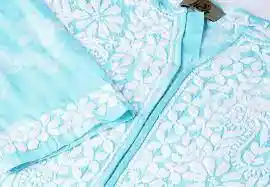Chikankari, the luxurious artwork
Chikankari designs on kurtis have been in vogue recently in this era. From dark shades to pastel ones, they have been stealing hearts. Its timeless elegance has earned it a number of hearts. Along with other valuable gifts, the city of Nawabs has also gifted India the art of Chikankari, or the Chikankari design.

The gorgeous chikankari, Image source- Ada chikan
The intricate embroidery designs have always been among people's choice lists. They are not only eye-catching but also graceful. With time, embroidery designs have evolved, and a plethora of designs have surfaced. One of those embroidery varieties is the Chikankari, which has become a statement today.
It is one of the oldest designs that dates back to the 3rd century BC, there are numerous allusions to these earliest designs. The Greek traveller, Megasthenes, hints at the typical floral designs of spelling
. However, it is crystal clear that its origin is credited to Lucknow.
According to one version, a traveller was on his journey when he stopped at a village in Lucknow. Exhausted by the trip, he asked a peasant for some water. He was impressed by the poor peasant's hospitality. In return, the traveller taught him the art of Chikankari. The peasant started the business in Lucknow, and since then, Lucknow has become famous for it.
Some people also claim that Empress Noor Jahan brought Chikankari to India. She invited artisans from Persia to create aesthetic Indo-Persian designs. Finally, when the Chikankari was created, it became the favourite of the Mughals.
The word Chikankari comes from a Persian word, "chikin," or "chikeen," which means silk embroidery. It was knitted and stitched together by hand to create elegant designs for the royals. It was traditionally a white-on-white design made on a muslin cloth called Tanzeb. It had a very superior status during the era and was considered an elite symbol in the royal court of the Nawab.
Even during the British era, Chikankari was a symbol of richness. Women had to wear chikan–embroidered sarees to portray themselves as eligible to tie a knot with a man of a higher class.
There are three main types of stitching: flat stitches (fine, tight stitches), embossed stitches (grainy textured), and embroidered stitches ( subtle net effect). The art of chikankari undergoes a series of procedures like cutting, stitching, printing, embroidery, washing, and finishing. The complete process takes around 12 days. The designs include floral designs of jasmine, roses and lotus that are adorned all over the cloth or in the corners.
Nowadays, Chikankari is also found on bedsheets, cushions, dresses, etc. Its style has also evolved with time, depending on materials and regions. Different variations, including Kundan's work and Khussab, have shaken the markets. The tanzeb is replaced with chiffon, cotton and georgette. However, the essence and value of Chikankari are still the same. It has been ruling Indian hearts and will continue to do so.


